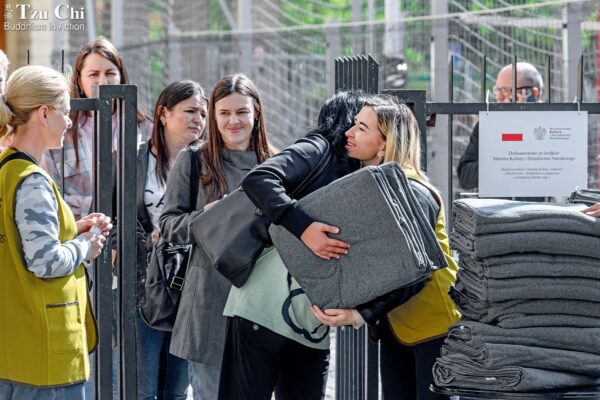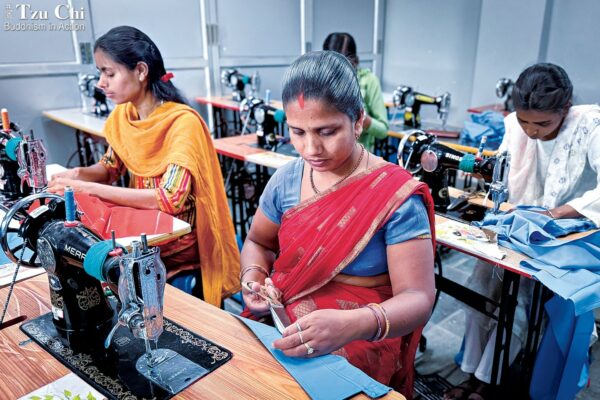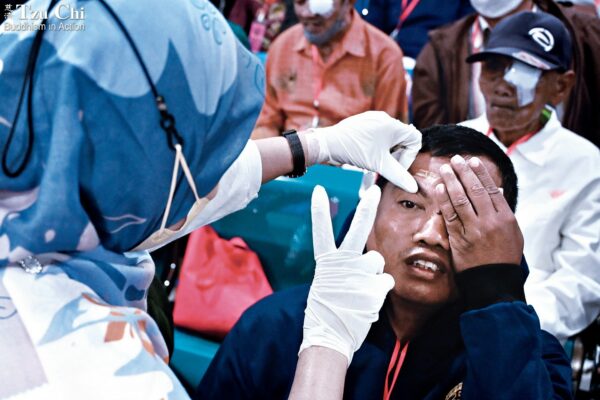By Wei Yu-xian
Translated by Wu Hsiao-ting
Photos by Chen Li-xue
A Taiwanese volunteer reflects on her visit to Bodh Gaya, where she participated in Tzu Chi’s charitable missions.
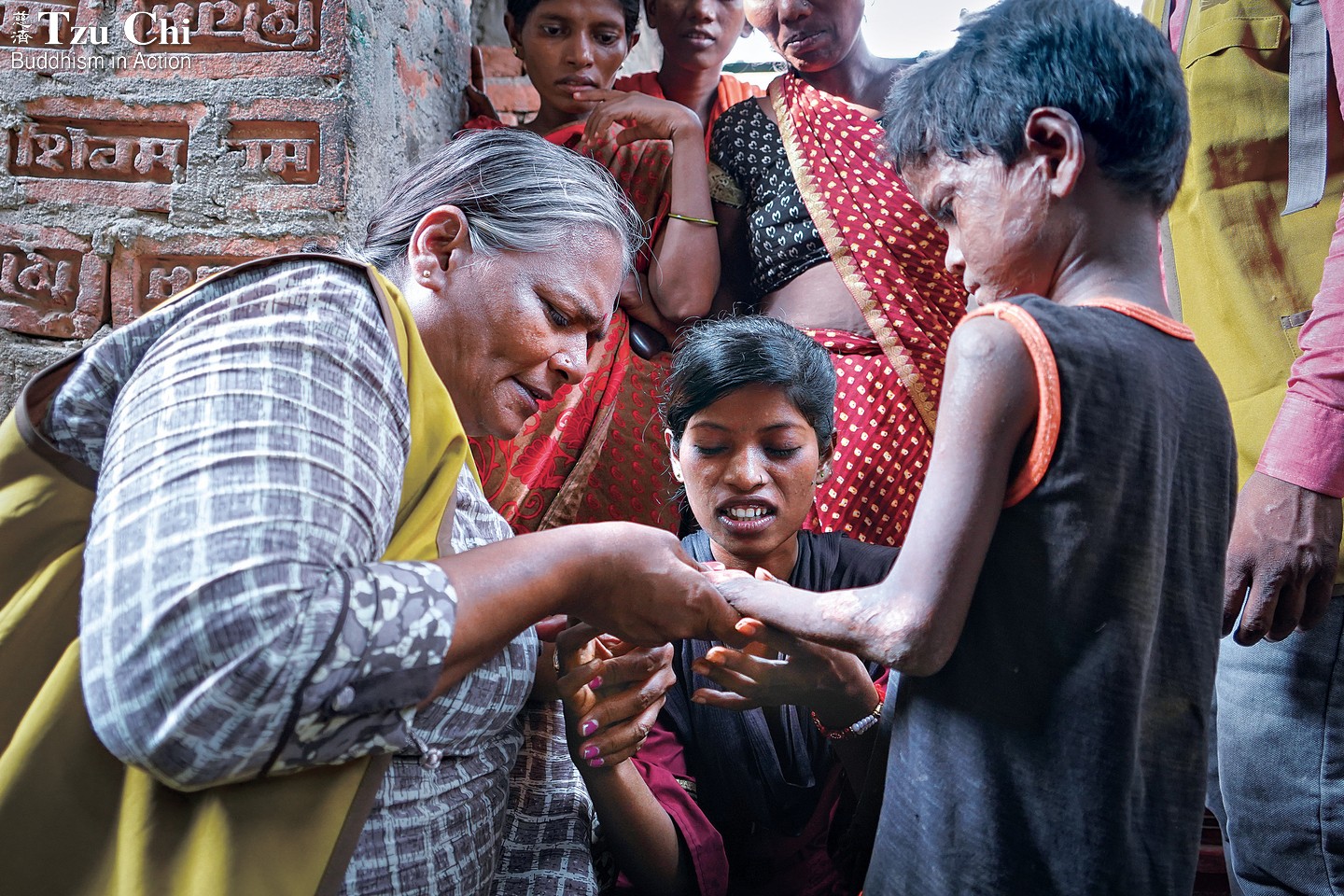
Dr. Chitra visited Bakraur village on September 12, 2023, to check on three medical cases, one of which involved a six-year-old boy with burn injuries. Ye Jin-hong
On September 9, 2023, I arrived at the Tzu Chi office in Bodh Gaya, along with 11 fellow volunteers from Malaysia. We were welcomed by Brother Sio Kee Hong (蘇祈逢), the deputy CEO of Tzu Chi Kuala Lumpur and Selangor, who had been stationed in Bodh Gaya since February 2023. He exclaimed, “Coming to Bodh Gaya, you’ll attain buddhahood more quickly!”
His words hinted at the challenges that lay ahead, but having mentally prepared for the Indian heat and food, I didn’t take his words to heart.
Sister Chen Li-xue (陳麗雪) and I both hail from Taichung, Taiwan. My primary responsibility during this trip was text documentation, while she focused mostly on photography. She had arrived in India eight days before me, and had arranged for my accommodations. Thanks to her, I could quickly start my volunteer duties.
Dr. Chitra
Tzu Chi’s volunteer attendance system in Bodh Gaya was well-established and running smoothly by the time I arrived. The charity, medical, and education teams communicated daily through a group chat, sharing information about their upcoming work. Volunteers interested in joining any of the teams responded in the chat to arrange transportation. On the day after my arrival, Sister Chen and I decided to accompany Dr. Chitra’s medical team, documenting their health checkups for villagers and profiling the doctor herself.
Dr. Chitra, born in 1963, is a native of Chennai, India. In 1988, she married a man from Kota Kinabalu, Malaysia, and relocated with him to that city the following year, where she pursued a career in medicine. Introduced to Tzu Chi by a neighbor, she became involved in the foundation’s activities and officially joined the Tzu Chi International Medical Association 15 years ago. She retired as a physician in 2021. When she heard about Tzu Chi’s philanthropic endeavors in Bodh Gaya, she willingly volunteered her expertise. She arrived in early September 2023 and joined Tzu Chi’s medical team to provide healthcare services to impoverished villages.
We were immediately greeted with the strong odor of cow dung hanging in the air when we reached Ganga Bigha village, along with the medical team. We brushed against cows and sheep as we walked down the road and saw hens and their chicks foraging for food. The scenes were reminiscent of rural Taiwan in the 1950s and 1960s.
Dr. Chitra fluently greeted the villagers in a local dialect and inquired about their well-being. Some villagers had high blood pressure; her earnest advice to them was to stop drinking. Women suffering from illness shared their discomfort with her. Dr. Chitra sat beside them, holding their hands, speaking to them like family. The kind doctor always wore a warm smile, regardless to whom she was speaking. Due to my limited proficiency in English, I had to rely on a Malaysian volunteer for translation support during my interview with her. Fortunately, she didn’t mind, and it resulted in a wonderful connection between us.
The houses in the village were not numbered, so Sister Lim Kim Yan (林金燕), a retired nurse from Singapore and the medical team’s coordinator, implemented a practical solution. To facilitate the medical team’s work, she asked her team members to affix number tags on doors belonging to households interested in Tzu Chi’s health checkups. Villagers needing additional medical attention after the initial examinations were reported to the community clinic.
Tzu Chi also provided free monthly support for individuals facing economic difficulties and with a body mass index below 16, indicating they were severely underweight. The support entailed the provision of chickpeas, soybeans, and other legumes, aiming to enhance their nutritional intake.
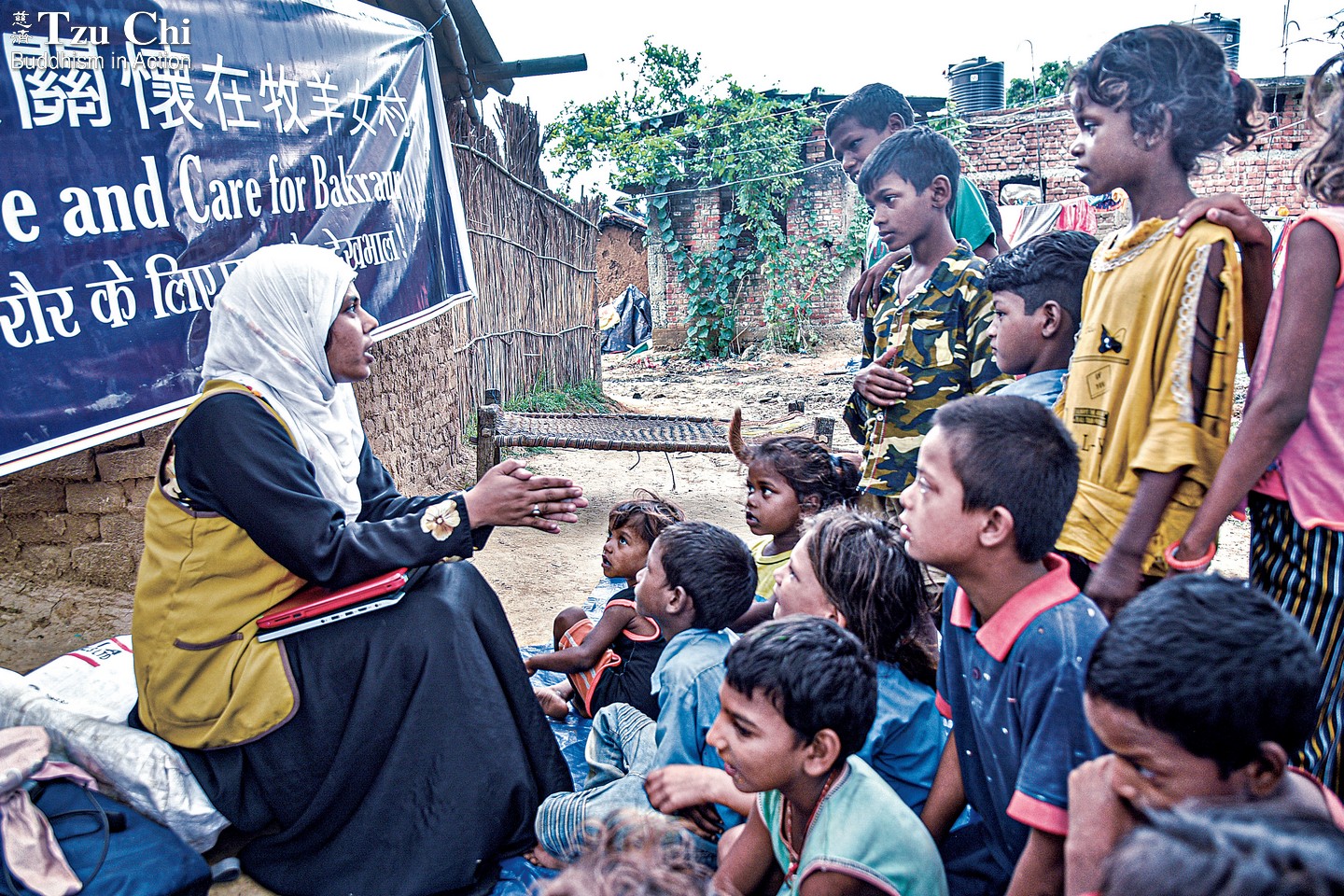
Children listen intently while volunteer Rozi Parween tells a story.
Classes under trees
At 3:30 in the afternoon on September 11, I joined the education team on a trip to Bakraur village. My mission was to document their weekly Tzu Chi class, conducted outdoors under the shade of a tree. During our journey in three tuk-tuks I observed lively scenes of children playing and frolicking outdoors and groups of women either seated in front of houses or holding small children.
When we arrived, I asked Sister Yaw Ah Moi, the education team’s coordinator, “Where are the participants of our class?” Without hesitation, she replied, “We’ll go find them!” The team swiftly sprang into action, going from house to house, inviting women and children to join our class. Some volunteers planned to teach the women how to sew scrunchies, while others would engage children in group activities. In just a short time, they had successfully gathered about 50 adults and children.
Seeing their proactive efforts to locate students left me utterly speechless. As a retired teacher, I was accustomed to children coming to class, not teachers actively seeking students. The education team’s enthusiastic spirit and proactive approach immediately won me over.
A different scene unfolded when I followed the education team to Silaunja village on the afternoon of September 15 for similar activities. Just before reaching our destination, Sister Yaw shared with me that when the team first started classes in the village, the tree they had chosen for their sessions didn’t provide enough shade. Consequently, the team made the decision to take the students and move deeper into the village in search of a larger, cooler tree under which to hold their classes.
However, when the team invited the children to move further into the village with them, their mothers hesitated. The mothers voiced concerns about the residents in the rear part of the village belonging to a lower social class than those in the front. As a result, the mothers were unwilling to let their children play with those in the back. Subsequently, each time the team passed through the village to reach the rear area for a class, the children who couldn’t participate could only watch eagerly as the team passed through.
When we arrived on the 15th, the children in the back of the village immediately held their chins with both hands, making the “Happy Face” gesture taught to them by Tzu Chi volunteers. The youngsters gathered under a tree and cheerfully participated in the group activities led by the education team. They obediently followed directions, jumping to the right, left, up, and down.
Our team shared an animated video recounting the tale, “The Elephant That Saved a Girl’s Life,” told by Master Cheng Yen. Volunteers Tan Lee Ting (陳麗婷) and Rozi Parween each held a laptop, playing the video, while Rozi explained the story in the children’s dialect.
These children hailed from families with modest means, and their homes typically had only essential items, such as beds and cooking ware. Since their families likely didn’t own televisions or cell phones, watching the video must have been fun for them. Every child stared intently at the small laptop screens. We weren’t certain if they fully grasped the story or not, but their focused expressions touched our hearts.
Regrettably, rain started to fall midway through the activity. Both adults and children scattered, some running back home, others seeking shelter in an empty house near the tree. After the rain subsided, everyone emerged from their shelters. Suddenly, Sister See Paik Lan (施依伶) slipped and fell on the slippery ground. Three more volunteers slipped in succession, getting their clothes and shoes covered in mud. The children, amused by the scene, erupted into laughter, which sparked laughter among the nearby adults as well. The four volunteers, caught up in the mirth and light-hearted atmosphere, momentarily forgot the awkwardness of their now mud-stained shoes and clothes.
As we were leaving the village, Sister See stopped me and said, “Yu-xian, this child has been holding my hand since I fell. It seems he’s afraid that I might fall again.” I turned around and captured this moment with my phone. I then asked Rozi to inquire on my behalf why the child was holding Sister See’s hand. The boy explained that in the video he watched earlier, when the big waves came, the little elephant saved the little girl, so he wanted to “save” Sister See too. This response deeply touched everyone. Isn’t this the best proof of the adage, “The mind, the Buddha, and living beings—there is no difference among these three”?
During her visit to Bodh Gaya in September 2023, Wei Yu-xian (魏玉縣), the author of this article, contemplates Prince Siddhartha’s journey in pursuit of the path of liberation.
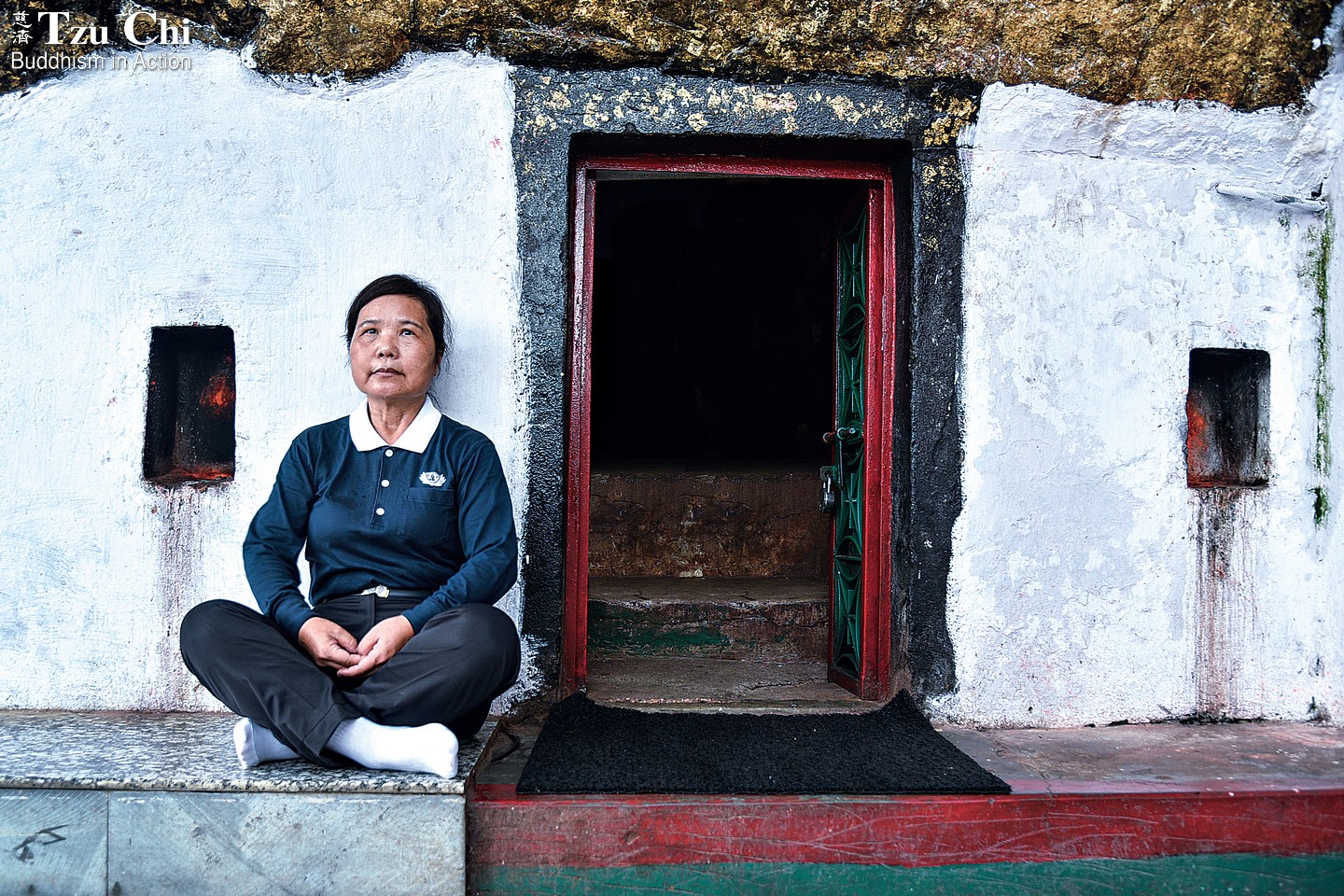
My heart remained in Bodh Gaya
The tuk-tuk is the most convenient means of transportation in Bodh Gaya. This three-wheeled electric vehicle has two rows of seats facing each other, allowing four people to ride. There is also space next to the driver for an additional passenger. Though the local roads are predominantly paved, they are riddled with potholes, turning the tuk-tuk ride into a bumpy journey that sways to the left and right. Passengers must hold tightly to a hanging ring in the tuk-tuk to keep themselves steady.
Experienced volunteers wisely cautioned us against extending our bodies beyond the metal bars next to the seats to avoid having them hit by passing vehicles. After a few days in Bodh Gaya, I noticed soreness in my shoulders, realizing it was from gripping a hanging ring too tightly. The dull pain in both upper arms, on the other hand, stemmed from bumping into the metal bars beside the seats.
Volunteers went out almost every day for Tzu Chi activities, and immersed themselves in their work at the Tzu Chi office when they returned. Oftentimes, their only interruptions were messages announcing that “Lunch is ready” or “Dinner is ready,” drawing them up to the top floor to enjoy the meals prepared by Malaysian volunteers. Given their routine, the days of the week and specific dates faded in importance. Even if there was a power outage during computer work or a shower, there was no need for concern. The generator quickly came to life, ensuring a continuous power supply.
Before I left to return to Taiwan on September 28, I wanted to see Raushni again. I first encountered the little girl, about the same age as my granddaughter, on my third day in Bodh Gaya. She was walking with her mother, hand in hand, in a crowd of people. The visible scars on her face and her right palm turned outward were remnants of a tragic fire accident. Curious about her story, I asked volunteer Seema and learned that Tzu Chi was already helping her, which relieved my concerns.
On September 26, Sister Lok Bee Hua took us to visit Raushni. As our tuk-tuk came to a stop near her house, the girl’s 30-year-old mother emerged from the house. She greeted us with a welcoming smile. Several children surrounded her, but Raushni was nowhere to be seen.
“Where is Raushni?” volunteer Vivek Kumar asked. “She’s playing outside,” the mother replied.
We found Raushni, wearing a bright dress, playing with her brother, sister, and neighboring children under a tree. She looked at us with big eyes while other children gathered around Sister Aw Kwai Wan and began singing. Raushni’s little brother, naked and covered in mud, asked us to hold him. Seeing his adorable appearance, everyone happily took turns holding him.
Sister Lok suggested that the mother dress her little son. She explained that the little one was reluctant to wear clothes and always took them off. Even so, she went inside her home, fetched clothes, returned, and patiently dressed him.
During our visit, we carefully examined the area on Raushni’s right thigh where skin had been taken for her facial reconstructive surgery. Noticing some scraped skin there, we advised her mother to apply medication regularly to prevent infection.
After playing some more with the children, we left with a sense of contentment. I held onto the hope that, with Tzu Chi’s assistance, Raushni could look forward to a brighter and better future.
On my second day back in Taiwan, I strolled along a mountain path behind my home. I hadn’t traversed this trail in a month. As I gazed at Taichung City below, my thoughts wandered to Bodh Gaya. “Today, the charity team is visiting Bakraur to teach women handicrafts; the education team is organizing an athletic event at a school; the medical team is….”
Although I was physically in Taiwan, my heart remained in Bodh Gaya.

